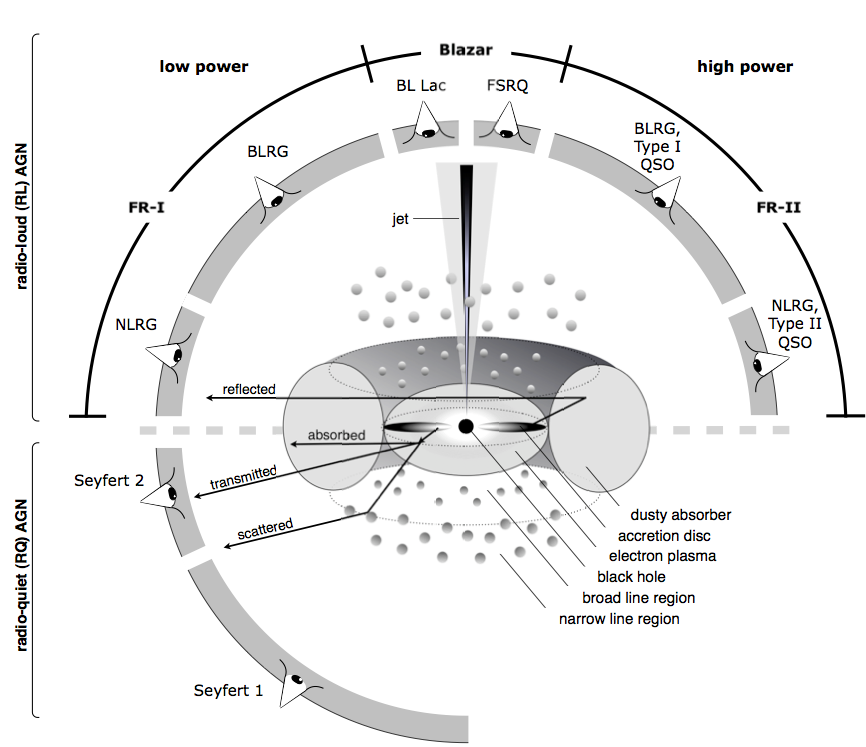An active galactic nucleus (ANG) is an area in the center of a galaxy characterized by enormously high luminosity appearing as a result of excessive emission of radio, microwave, optical, ultra-violet, infrared, gamma rays, and X-rays making AGNs the most persistent sources of electromagnetic radiation (Netzer 365).
In 1970, researchers discovered the area that they called Sagittarius A – a source of radio emissions situated in the center of a Milky Way Galaxy. It required several decades of close observation and evidence collection to hypothesize that this compact region was a supermassive black hole (SMBH). This led astronomers to the conclusion that every huge galaxy in the Universe should feature the same phenomenon (Beckmann and Shrader 13).
It was found out that most of the time, these holes are inactive and invisible to direct observation; however, when material falls inside of them, they start emitting huge amounts of radiation making ANGs more luminous than all the stars of the galaxy taken together. These areas are currently the major argument proving the existence of supermassive black holes (Beckmann and Shrader 13). The paper at hand is going to dwell upon the essence of the phenomenon, its types, and methods of detection.
Description of the Phenomenon
Even though AGNs are the best evidence of SMBH existence, it would be wrong to assume that its tremendous bursts of luminosity come from the holes as such: over a course of time, it became clear to researchers that it is impossible to even for light to escape the Event Horizon of SMBH (Netzer 367).
The search for the source of emissions has given rather surprising results: it turned out that all the rays (radio, microwave, optical, ultra-violet, infrared, gamma rays, and X-rays) are emitted from cold matter (including gas and dust) orbiting SMBH and forming accretion discs that feed the holes. The gravity force of the area is so unbelievably high that the material forming the disk gets compressed until the temperature exceeds millions of degrees Kelvin, which leads to radiation outbursts. The accretion disk gets surrounded by a corona of hot matter emitting photons (Netzer 367).
As a result of the interaction of cold matter with supermassive black holes, practically the whole electromagnetic spectrum is produced, though a huge fraction of radiation can be sometimes obscured owing to gas and dust that orbit the accretion disk (Beckmann and Shrader 25).
Since the SMBH has a magnetic field, it inevitably has to come into contact with the accretion disk. As a result of this interaction, magnetic jets are produced. Such jets can extend for many thousands of light-years firing material outside the black hole at relativistic speeds and serving as a second source of emissions (Beckmann and Shrader 28).
Types of AGN
The most typical classification of AGNs is the division into two major categories: radio-quiet AGNs and radio-loud ones. The latter type refers to nuclei that are characterized by the ability of both the accretion disk and the magnetic jets to emit radiation, whereas the former category is much simpler (jet-related emission in them are reduced to the possible minimum, which means that only the accretion disk is active) (Netzer 370).
The first type of AGNs was discovered in 1943 by Carl Seyfert (and named after the astronomer a “Seyfert galaxy”) and is currently known for its emission lines that differentiate two major sub-categories: type 1 and type 2 Seyfert galaxies. The first type features both optical emission lines (narrow and broadened). This factor indicates that near the nucleus, there exist clouds of gas of high density and velocity (reaching 5000 km/s).
The second type is characterized by the absence of broadened emission lines. This leads to a low density of gas as well as its greater distance from the nucleus and a velocity of about 1000 km/s (Beckmann and Shrader 52).
Other sub-categories of radio-quiet galaxies include Low Ionisation Nuclear Emission-line Region galaxies (LINERs) and radio-quiet quasars (the ones without strong radio emission). LINERs have a lot in common with Seyfert 2 galaxies; however, unlike them, LINERs possess very strong low ionization lines. These AGNs are the ones with the lowest possible luminosity, which makes researchers doubt whether they are powered by accretion on to an SMBH (Beckmann and Shrader 53).
Radio-loud galaxies are further classified into three sub-types: radio galaxies (elliptical galaxies emitting radio waves), quasars (the most highly luminous type of active galactic nuclei with the spectrum similar to that of Seyferts), and blazars (a variable type of AGNs that emits radio waves without showing emission lines in the spectrum). All three differ in the stellar absorption capacity depending on the density of the gas (absorption features can be either weak or completely absent). Their emission lines are narrow and weak in comparison to those of Seyferts (Beckmann and Shrader 53).

Detection of Active Galactic Nuclei
Astronomers investigating the phenomenon of AGNs discovered several characteristics that have to be found in the center of galaxies to refer them to AGNs. For example, the visibility of nuclear-optical and infra-red emissions regardless of the fact whether it is possible to directly observe the accretion disk itself (which can be made obscure by cold matter orbiting the nucleus) (Netzer 374).
Moreover, as has been mentioned above, there are broadened and narrow optical emission lines the presence of which can help differentiate between different types of AGNs. The former type appears each time the emitting cold matter that revolves around the SMBH at high speed approaches it. It causes Doppler shifts of the photons that get emitted as a result of this interaction. Narrower lines are produced when gas and dust are more distant (Netzer 376).
The next way of ANGs detection is the presence of radio continuum and X-ray continuum radiation, which can be emitted either from the jet or from the corona with dispersed electromagnetic radiation. Also, there exist X-ray line emissions appearing due to the illumination of cold matter (situated in-between) by x-ray emission (Beckmann and Shrader 62).

These indicators (no matter if they are taken together or separately) allowed astronomers to investigate the center of galaxies to understand whether their nuclei are active or not.
The Milky Way Galaxy
Having analyzed the material accreted onto Sagittarius A, researchers concluded that the nucleus of the Milky Way Galaxy cannot be referred to as active. There is a hypothesis that the galaxy used to have an active nucleus but later entered its radio-quiet period, which can end in several million years. There is a supposition that when the Andromeda Galaxy merges with the Milky Way Galaxy, their SMBHs will also become one, which implies that the nucleus will have a sufficient amount of material to become active (Beckmann and Shrader 65).
Works Cited
Beckmann, Volker, and Chris Shrader. Active Galactic Nuclei. John Wiley & Sons, 2013.
Netzer, Hagai. “Revisiting the Unified Model of Active Galactic Nuclei.” Annual Review of Astronomy and Astrophysics, vol. 53, no. 1, 2015, pp. 365-408.